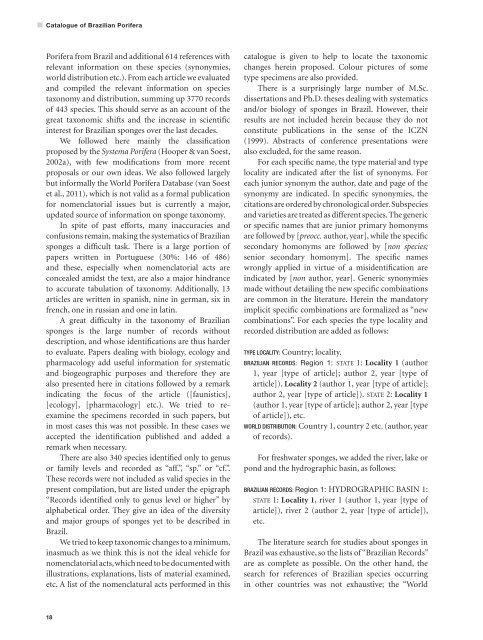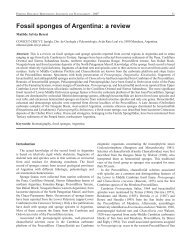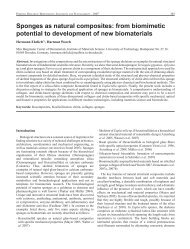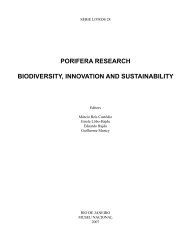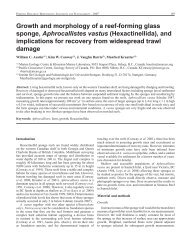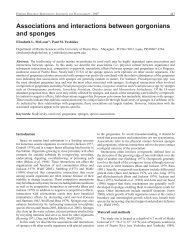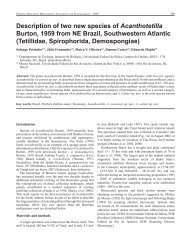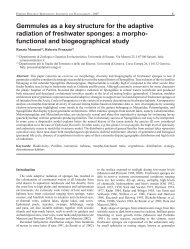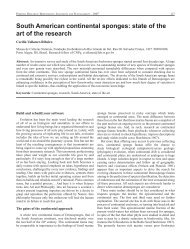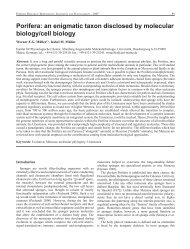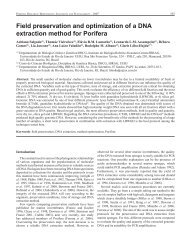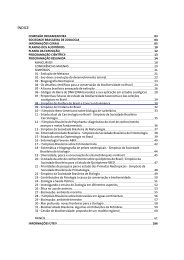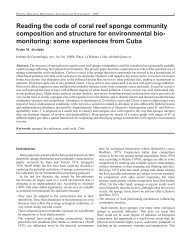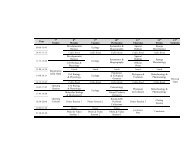Catalogue of Brazilian Porifera - Porifera Brasil - UFRJ
Catalogue of Brazilian Porifera - Porifera Brasil - UFRJ
Catalogue of Brazilian Porifera - Porifera Brasil - UFRJ
You also want an ePaper? Increase the reach of your titles
YUMPU automatically turns print PDFs into web optimized ePapers that Google loves.
<strong>Catalogue</strong> <strong>of</strong> <strong>Brazilian</strong> <strong>Porifera</strong><strong>Porifera</strong> from Brazil and additional 614 references withrelevant information on these species (synonymies,world distribution etc.). From each article we evaluatedand compiled the relevant information on speciestaxonomy and distribution, summing up 3770 records<strong>of</strong> 443 species. This should serve as an account <strong>of</strong> thegreat taxonomic shifts and the increase in scientificinterest for <strong>Brazilian</strong> sponges over the last decades.We followed here mainly the classificationproposed by the Systema <strong>Porifera</strong> (Hooper & van Soest,2002a), with few modifications from more recentproposals or our own ideas. We also followed largelybut informally the World <strong>Porifera</strong> Database (van Soestet al., 2011), which is not valid as a formal publicationfor nomenclatorial issues but is currently a major,updated source <strong>of</strong> information on sponge taxonomy.In spite <strong>of</strong> past efforts, many inaccuracies andconfusions remain, making the systematics <strong>of</strong> <strong>Brazilian</strong>sponges a difficult task. There is a large portion <strong>of</strong>papers written in Portuguese (30%: 146 <strong>of</strong> 486)and these, especially when nomenclatorial acts areconcealed amidst the text, are also a major hindranceto accurate tabulation <strong>of</strong> taxonomy. Additionally, 13articles are written in spanish, nine in german, six infrench, one in russian and one in latin.A great difficulty in the taxonomy <strong>of</strong> <strong>Brazilian</strong>sponges is the large number <strong>of</strong> records withoutdescription, and whose identifications are thus harderto evaluate. Papers dealing with biology, ecology andpharmacology add useful information for systematicand biogeographic purposes and therefore they arealso presented here in citations followed by a remarkindicating the focus <strong>of</strong> the article ([faunistics],[ecology], [pharmacology] etc.). We tried to reexaminethe specimens recorded in such papers, butin most cases this was not possible. In these cases weaccepted the identification published and added aremark when necessary.There are also 340 species identified only to genusor family levels and recorded as “aff.”, “sp.” or “cf.”.These records were not included as valid species in thepresent compilation, but are listed under the epigraph“Records identified only to genus level or higher” byalphabetical order. They give an idea <strong>of</strong> the diversityand major groups <strong>of</strong> sponges yet to be described inBrazil.We tried to keep taxonomic changes to a minimum,inasmuch as we think this is not the ideal vehicle fornomenclatorial acts, which need to be documented withillustrations, explanations, lists <strong>of</strong> material examined,etc. A list <strong>of</strong> the nomenclatural acts performed in thiscatalogue is given to help to locate the taxonomicchanges herein proposed. Colour pictures <strong>of</strong> sometype specimens are also provided.There is a surprisingly large number <strong>of</strong> M.Sc.dissertations and Ph.D. theses dealing with systematicsand/or biology <strong>of</strong> sponges in Brazil. However, theirresults are not included herein because they do notconstitute publications in the sense <strong>of</strong> the ICZN(1999). Abstracts <strong>of</strong> conference presentations werealso excluded, for the same reason.For each specific name, the type material and typelocality are indicated after the list <strong>of</strong> synonyms. Foreach junior synonym the author, date and page <strong>of</strong> thesynonymy are indicated. In specific synonymies, thecitations are ordered by chronological order. Subspeciesand varieties are treated as different species. The genericor specific names that are junior primary homonymsare followed by [preocc. author, year], while the specificsecondary homonyms are followed by [non species;senior secondary homonym]. The specific nameswrongly applied in virtue <strong>of</strong> a misidentification areindicated by [non author, year]. Generic synonymiesmade without detailing the new specific combinationsare common in the literature. Herein the mandatoryimplicit specific combinations are formalized as “newcombinations”. For each species the type locality andrecorded distribution are added as follows:TYPE LOCALITY: Country; locality.BRAZILIAN RECORDS: Region 1: State 1: Locality 1 (author1, year [type <strong>of</strong> article]; author 2, year [type <strong>of</strong>article]). Locality 2 (author 1, year [type <strong>of</strong> article];author 2, year [type <strong>of</strong> article]). State 2: Locality 1(author 1, year [type <strong>of</strong> article]; author 2, year [type<strong>of</strong> article]), etc.WORLD DISTRIBUTION: Country 1, country 2 etc. (author, year<strong>of</strong> records).For freshwater sponges, we added the river, lake orpond and the hydrographic basin, as follows:BRAZILIAN RECORDS: Region 1: HYDROGRAPHIC BASIN 1:State 1: Locality 1, river 1 (author 1, year [type <strong>of</strong>article]), river 2 (author 2, year [type <strong>of</strong> article]),etc.The literature search for studies about sponges inBrazil was exhaustive, so the lists <strong>of</strong> “<strong>Brazilian</strong> Records”are as complete as possible. On the other hand, thesearch for references <strong>of</strong> <strong>Brazilian</strong> species occurringin other countries was not exhaustive; the “World18


